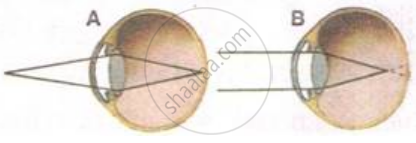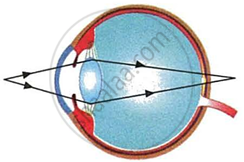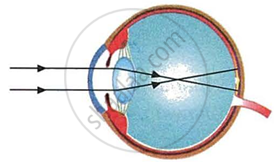Advertisements
Advertisements
प्रश्न
Differentiate between members of the following pair with reference to what is asked in the bracket.
Rods and cones (sensitivity).
उत्तर
Rods: They are sensitive to dim light but do not respond to colour.
Cones: They are sensitive to bright light and are responsible for colour vision.
APPEARS IN
संबंधित प्रश्न
What is myopia?
List three common refractive defects of vision. Suggest the way of correcting these defects.
Explain two possible reasons of myopia. How can it be corrected? Explain with a suitable diagram.
the biological/technical terms for the lens of eye losing flexibility resulting in a kind of long-sightedness in middle aged people.
Name any two defects of vision which can be corrected by using spectacles.
What is the far point of a person suffering from myopia (or short-sightedness)?
Your friend can read a book perfectly well but cannot read the writing on blackboard unless she sits on the front row in class.
What type of lenses-converging or diverging-would an optician prescribe for her?
A person cannot see the distant objects clearly (though he can see the nearby objects clearly). He is suffering from the defect of vision called:
(a) cataract
(b) hypermetropia
(c) myopia
(d) presbyopia
The picture given here shows a person wearing 'half-moon' spectacles. What sort of eye-defect do do you think he has? Why are these particular spectacles useful to him?
To read a book held at a distance of 25 cm, will she need converging or diverging spectacle lenses?
By closing the eyes and gently pressing them by your palms, you may see some specks of brilliant light. How do you get this sensation while there is no light entering your eyes?
What eye defect is hypermetropia? Describe with a ray diagram how this defect of vision can be corrected by using an appropriate lens.
Given below is a diagram depicting a defect of the human eye? Study the same and answer the question that follow:

Draw a labeled diagram to show how the above mentioned defect is rectified using the lens named above.
Have a look at the posture of this woman who is reading a book and answer the questions which follow:

What are the two conditions shown in sections A and B of the eye as applicable to her?
A person is unable to see objects distinctly placed within 50 cm from his eyes.
(a) Name the defect of vision the person is suffering from and list its two possible causes.
(b) Draw a ray diagram to show the defect in the above case.
(c) Mention the type of lens used by him for the correction of the defect and calculate its power. Assume that the near point for the normal eye is 25 cm.
(d) Draw a labeled diagram for the correction of the defect in the above case.
Explain the Term: Presbyopia
A person cannot see distinctly objects kept beyond 2 m. This defect can be corrected by using a lens of power:
Draw ray diagram showing myopic eye.
Match the following:
| Column - I | Column - II |
| 1. Retina | a. Path way of light |
| 2. Pupil | b. Far point comes closer |
| 3. Ciliary muscles | c. near point moves away |
| 4. Myopia | d. Screen of the eye |
| 5. Hypermetropia | e. Power of accommodation |
Have a look at the posture of this girl who is reading a book and answer the questions which follow:
 |
- Name the problem she is facing.
- What are the two conditions shown in sections A and B of the eye as applicable to her.
- What kind of reading glasses does she need?
 |
 |
| A | B |
